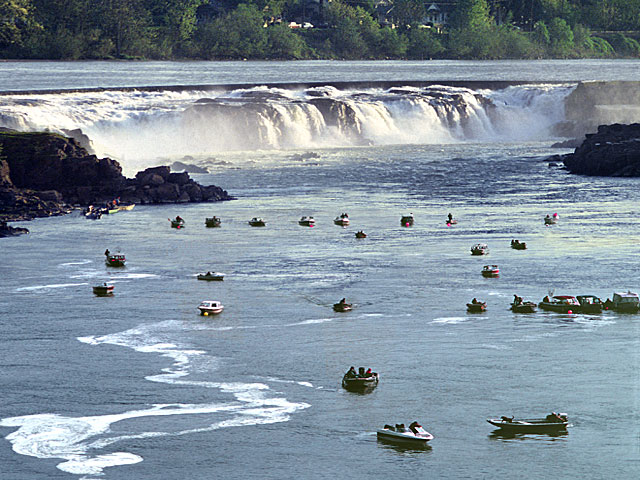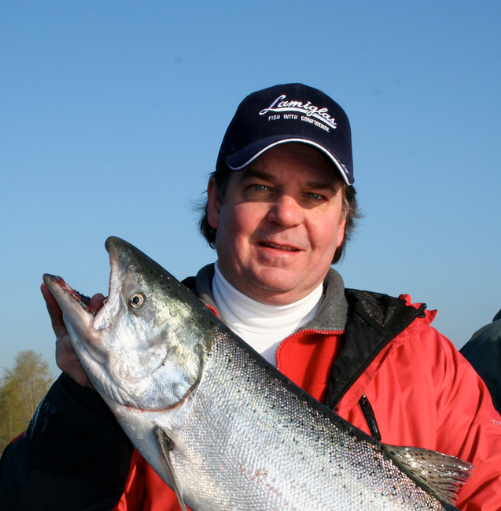If you could find a chunk of spring Chinook in a store the price would be somewhere around $50 pound. As expensive as it is, it’s worth every dollar. Spring Chinook, whether it’s Columbia River, Willamette River, Rogue River or Tillamook Bay springers, all share the same quality — Omega 3. They are loaded with a buttery fat that imparts a singularly unique flavor to this salmon that makes it exceptional!
As their name suggests, “springers” show-up in the spring but instead of finding their natal waters and spawning right away, they take their own sweet time and spend months in the river, spawning instead in fall. The late timing of their spawning run results in a genetic difference that has them packing on fat to sustain themselves over the months before they spawn.
Springers start to show in the Columbia Basin, mainly the Willamette, as early as December, though most years it’s January or early February when the first springer is caught. Peak fishing for spring Chinook is generally in April on the Columbia, however, it’s often closed early in the month to protect Snake River-bound wild Chinook. In the Willamette peak fishing is in April and May. On the Rogue, April and May. And in Tillamook Bay, mid-May through the end of the month is prime time.
Each of these fisheries favors its own unique methods, and in many cases those methods change depending where and when you’re fishing a particular river or bay.
The Columbia Basin, for good reason, receives the lion’s-share of the pressure. It’s the one that gets all the fish. The largest return of spring Chinook occurs in this basin, by far, with a substantial number of fish peeling off into the Willamette and its tributaries.
The popularity of this fishery is unmatched in the region. The Columbia River/Willamette spring Chinook fishery receives more “angler days” than any other seasonal fishery in the Northwest. On a year with strong returns more than 200,000 angler days are logged from March through June.
Some interesting developments over the last couple of years have evolved extending the “peak” of this fishery through June and into July.
Look for 2021 to be a good year for springers.

As I write this, fish are already being caught. It’s been slow and steady with several fish in the 30 pound range already weighed. For springers those are really nice fish. Most will average 16 pounds. The forecast calls for a small uptick over last year’s return in the Columbia and 10,000 more springers are expected in the Willamette system. Good snowpack bodes well for optimal water conditions this year which helps considerably in getting these fish to bite.
For most, April is the month that gets most of the attention on the lower-Willamette, that 27 mile section of river that runs from Oregon City to the mouth. The techniques change depending on what part of the river you’re fishing.
The section of river in and around Oregon City tends to be a late-April, early-May show with boats either on anchor, back-trolling baits and plugs or back-bouncing bait as the primary tactics. These techniques depend on a steady current to work. It becomes a troll-fishery by the time you get to the Lake Oswego and Milwaukie-area of the river as the current slows to an imperceptible crawl. Prawns, sand shrimp and herring are all popular baits here. Often rigged behind a “triangle flasher”, of which there are several types to choose from.
Be forewarned, this section of river, from the falls at Oregon City downriver to the Cedar Oaks launch on the west side of the river is the most congested. It’s not at all uncommon for there to be well over a hundred boats in this short stretch.

360 flashers have become more prevalent and popular as they impart an action to the bait along with flash. The 360 flasher combo rigged with a 3.5 spinner has been the hot ticket up and down the river the past couple of years. Especially in May and June in the lower-river often referred to as the “Portland Harbor”. That fishery has added two more months of dependable catching. There, it’s like lake trolling using salmon-sized gear. The typical combo is 12 ounces of lead, fished at 20’ on line-counter level wind reels. This has been the new development to springer fishing mentioned earlier that’s been evolving over the past 15 years or so.
A decade and a half ago, a few guides continued to fish downriver of the St. Johns Bridge in the Willamette, and quietly caught spring Chinook. Since then, more and more people have accepted the fact that salmon can be caught after April, through May and June and even into July! Last season saw limits of springers being caught into July!
In the Willamette, most of the pressure dies by early May. For some, that’s when the best fishing is found. From downtown Portland up to Lake Oswego, there’s only a few boats left but the fish are still motoring their way through town bound for upriver tributaries. Springers never got the 411 the season ends in April.
Just a few years ago, it was mid-May as we trolled herring out in front of Waverly Country Club on the Willamette. Just a mile or so upriver was downtown Milwaukie. We’d already boated one perfect, dime-bright salmon as the rod started to bounce. It looked like a trout bite. We let it peck. Then after about 50 feet of gentle nibbles the rod lurched and the rod tip nearly broke the surface of the water against the thundering take of an ocean-fresh springer.
We put four beautiful fish in the box that day. About $2,500 of salmon at market rate. And we were it — not another boat in sight, and that’s how May fishing generally is, very light traffic, unencumbered fishing under clear skies and warming temps, and plenty of fish to catch.
The Tillamook Bay springer fishery has a very narrow window, about three weeks most years, and the run is relatively small, only 2,500 fish or so return. For those few who are fortunate enough to land one of these salmon they are rewarded with a fish that’s still in saltwater when it’s caught and is brimming with the precious fat that makes them so delicious.
Trolled herring or spinners are the two techniques that are generally used to catch Tillamook Bay spring Chinook. Most of the effort occurs at the Ghost Hole or at Memaloose, the Picket Fence or Sheep’s Corral in the upper-bay.
A word of caution, unless you’re already familiar with Tillamook Bay you’re well-advised to first learn the bay under the guidance of someone who knows where to go and how to fish it. The bay is vast but it’s mostly shallow with only a few well-defined channels that cut through it. Take a wrong turn and you’ll likely be grounded.
If you’re thinking the Rogue River fishery is where you want to plant your stake for springers its sound advice to hire a guide before you go it alone. The tactics and techniques are very specialized right down to the river anchors they use and how they anchor. If you’re off by a couple feet on where you’ve positioned your boat you can be completely out of the path of where fish funnel through as they migrate upriver. The riggings, gear and tactics that are favored on the Rogue are specific to that river and they work well, which is another reason to leave the driving to a local guide, at least for a day or two so you can size it up.
Oregon’s spring Chinook are arguably the finest eating fish to be found on the planet.
It’s a big statement for sure but backed up by chefs worldwide who regard this fish as “the best”. As table fare, these fish are reason enough to catch them but for anyone who likes to wet a line, the power and tenacity of these fish is equally compelling. And know you’ll need to invest yourself in catching them. The average amount of time it takes most anglers to catch one of these salmon is about 80 hours. 40 hours in a year of abundance. Yet, upwards of 200,000 angler days will be spent chasing these silvery prizes. The more time you put in, the more years you give to this pursuit the less time you’ll need to catch each one. But no matter where you are on the continuum of springer-fishing-experience, you’ll have to put your time in. This is a great year to start…good luck!